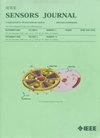Flexible Screen-Printed Carbon-Based Electrode Functionalized With Multiwall Carbon Nanotubes for Portable Point-of-Care pH Sensing
IF 4.3
2区 综合性期刊
Q1 ENGINEERING, ELECTRICAL & ELECTRONIC
引用次数: 0
Abstract
Flexible, screen-printed electrode (SPE) systems offer significant advantages in biomedical applications due to their rapid fabrication capability and adaptability to irregular surfaces. Despite this, no flexible, screen-printed biosensors for pH measurement are readily available on the market. This article introduces an innovative fabrication technique for integrating flexible SPE systems with multiwall carbon nanotubes (MWCNTs). These SPE systems feature flexible screen-printed working electrodes (WEs) functionalized with MWCNTs (f-MWCNTs) for pH sensing, achieving a fabrication success rate of 78.57%. Furthermore, these SPE systems have been optimized to improve voltage changes and thoroughly characterized for performance using pH buffer solutions. This was done utilizing open-circuit potentiometry. The results demonstrate that the SPE systems can detect pH ranges from 4.0 to 8.9 with an average sensitivity of 33.66 mV/pH, an output range of 202.62 mV, a settling time of 19.71 s, and stability for up to 72 h. Additionally, the SPE systems have been tested with artificial saliva in the pH range of 5.0–8.3, achieving a sensitivity of 44.86 mV/pH and an output range of 192.90 mV. These findings pave the way for further exploration in pH sensing research, particularly utilizing SPE systems coated with MWCNTs.求助全文
约1分钟内获得全文
求助全文
来源期刊

IEEE Sensors Journal
工程技术-工程:电子与电气
CiteScore
7.70
自引率
14.00%
发文量
2058
审稿时长
5.2 months
期刊介绍:
The fields of interest of the IEEE Sensors Journal are the theory, design , fabrication, manufacturing and applications of devices for sensing and transducing physical, chemical and biological phenomena, with emphasis on the electronics and physics aspect of sensors and integrated sensors-actuators. IEEE Sensors Journal deals with the following:
-Sensor Phenomenology, Modelling, and Evaluation
-Sensor Materials, Processing, and Fabrication
-Chemical and Gas Sensors
-Microfluidics and Biosensors
-Optical Sensors
-Physical Sensors: Temperature, Mechanical, Magnetic, and others
-Acoustic and Ultrasonic Sensors
-Sensor Packaging
-Sensor Networks
-Sensor Applications
-Sensor Systems: Signals, Processing, and Interfaces
-Actuators and Sensor Power Systems
-Sensor Signal Processing for high precision and stability (amplification, filtering, linearization, modulation/demodulation) and under harsh conditions (EMC, radiation, humidity, temperature); energy consumption/harvesting
-Sensor Data Processing (soft computing with sensor data, e.g., pattern recognition, machine learning, evolutionary computation; sensor data fusion, processing of wave e.g., electromagnetic and acoustic; and non-wave, e.g., chemical, gravity, particle, thermal, radiative and non-radiative sensor data, detection, estimation and classification based on sensor data)
-Sensors in Industrial Practice
 求助内容:
求助内容: 应助结果提醒方式:
应助结果提醒方式:


